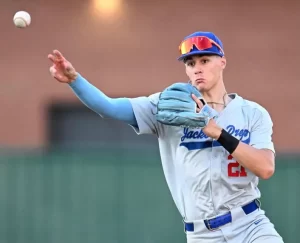Garrett Crochet has more similarities to Chris Sale than ‘hard-throwing lefty’

KNOXVILLE, TN - MAY 03, 2019 - Pitcher Garrett Crochet #34 of the Tennessee Volunteers during the game between the Missouri Tigers and the Tennessee Volunteers at Lindsey Nelson Stadium in Knoxville, TN. Photo By Andrew Ferguson/Tennessee Athletics
The MLB draft is never short on player comps. Fans want to know what their team just got in the draft.
Scouts and analysts search for similarities between a draft pick and a known commodity in the majors. Far too often, these young amateur prospects get compared to all-stars and hall of famers. Even in the first round, the draft is a crap shoot and most of these players won’t live up to those lofty comparisons.
This year, the high-end comparison for the first White Sox pick, Garrett Crochet, was a very familiar name: Chris Sale. Al Leiter shouted it out, even putting the deliveries of the two lefties side-by-side in a video on the MLB Network draft broadcast.
Before, this gets too far, no one is predicting Crochet is going to be one of the best left-handed starters of his era, which Sale is. Still, the similarities are obvious.
For starters, both are 6-foot-6 lefties with elite velocity whom the White Sox drafted out of college. Sale was thought of as an elite talent, but fell to No. 13 in 2010 due to concerns about his signability, injury concerns about his delivery and whether or not he would remain a starter long-term.
There haven’t been explicit concerns about Crochet’s delivery, although they do share a similar arm angle. There also aren’t any doubts about Crochet signing (the draft rules have changed since 2010). He does, however, share questions about whether he’s a starter or reliever long-term.
Jim Callis took it a step further a couple minutes after Leiter analyzed Crochet, saying the White Sox could put him on a similar track as they did with Sale in 2010.
“They drafted (Sale) and they said ‘Look, if you pitch well in the minors… you can come contribute in a pennant race’ and he did that,” Callis said. “Chris Sale began his career as a reliever before going to starter. The White Sox are definitely going to contend this year. I don’t see why (Crochet) couldn’t do that.
“I think you do exactly what you did with Chris Sale. You think about using him as a reliever this year, but you worry about developing him as a starter in the future.”
Sale reported directly to High-A Winston-Salem, where he made four relief appearances before jumping up to Triple-A Charlotte. After just seven more appearances, where Sale racked up 15 strikeouts in 6 1/3 innings, Sale was promoted to the majors. He pitched out of the MLB bullpen the rest of 2010 and then in a full season in 2011. By 2012, he was an all-star starter, which was the first of seven straight All-Star Game appearances.
The White Sox can’t put Crochet on exactly the same track because, as Callis pointed out, there won’t be a minor league season for him to take similar beginning steps. However, he could begin his pro career as a reliever, maybe even this year if the White Sox find a need for him. The White Sox have proven they can develop a successful starting pitcher that way. Amateur scouting director Mike Shirley said they view him as a starter.
There’s one more similarity that is more explicit.
“I definitely see the similarities and actually when I was developing my slider I kind of tried to shape it the same way that his is so he was definitely a mentor for me that I kind of viewed from social media platforms and just watching as he played,” Crochet told White Sox reporters on Wednesday.
So the White Sox just drafted Chris Sale 2.0? Let’s all get excited and pencil him into the 2021 bullpen and the 2022 rotation! OK, maybe not.
There is a glaring difference between the draft profiles of the two. Sale was absolutely dominant in college. As a sophomore in 2009, Sale struck out 104 batters in 89 1/3 innings with a 2.72 ERA. In 2010 he followed up with 146 strikeouts against just 14 walks in 103 innings with a 2.01 ERA. Granted, Sale was at Florida Gulf Coast and not in the SEC like Crochet, but that’s as good as it gets.
Conversely, Crochet only made 13 starts in his collegiate career. Some of that is due to the shortened 2020 season, but he only made six starts as a sophomore. Crochet racked up 81 strikeouts with 22 walks in 65 innings with a 4.02 ERA that year. That’s not bad for the SEC, but it doesn’t stand out as first-round production. Then again, he didn’t get to show his improvement as a junior.
The comparisons between Crochet and Sale are inevitable now that the White Sox drafted him. If he busts fans will roll their eyes at the lefty who was once compared to Chris Sale. One thing is for sure, you won’t hear the White Sox tout that comparison.
Don’t expect Crochet to be Sale. After the pick, Shirley told reporters he views Crochet as a No. 3 starter “with some hope for more.” Still, it’s hard to deny they share a number of traits. Certainly as far as recent White Sox prospects go, Sale is the most similar to Crochet.
“I feel like it’s kind of tough to make on me as I have not achieved anything as close to Chris has achieved, but it’s definitely nice to hear and nice to see,” Crochet said.
Photo Credit: Andrew Ferguson/Tennessee Athletics
Want to know right away when we publish a new article? Type your email address in the box on the right-side bar (or at the bottom, if on a mobile device) and click the SUBSCRIBE button. Our list is completely spam free, and you can opt out at any time. Also, consider supporting FutureSox on Patreon! You will get early access to special articles and Patreon-only posts, in addition to more benefits. Shop our exclusive merchandise! Show your support with the latest FutureSox apparel.








Fulmer also had better production in the SEC as a starter and reliever.
Let him develop in a pace that is appropriate. There is no immediate need to rush him. He may come in with the Thompson, Dalquust, Noira and Kelly wave